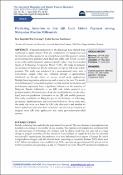Options
Predicting Intention To Use Qr Code Mobile Payment \r\nAmong Malaysian Muslim Millennials
Journal
The Journal of Muamalat and Islamic Finance Research (JMIFR)
Date Issued
2023
Author(s)
Syabil Nazhan Ahd.Moess
DOI
10.33102/jmifr.481
Abstract
Financial transactions in the digital age have shifted from traditional to digital systems. With the proliferation of smartphones and the internet, cashless payments via smartphone or mobile payment system are becoming more popular. Quick Response (QR) code mobile payment is one of the cashless payment options available today. Using the extended theory of Technology Acceptance Model (TAM), this study investigates the intention of Malaysian Muslim millennials to opt for QR code mobile payment. The study was conducted as a cross-sectional study with a convenience sample. Data was collected through a questionnaire distributed via Google forms on various social media applications. Multiple linear regression analysis was used to analyse the data. The results showed that perceived usefulness, perceived risk, hedonic motivation, and performance expectancy have a significant influence on the intention of Malaysian Muslim millennials to use QR code mobile payment as a payment method. Perceived ease of use and social influence, on the other hand, were not predictors of intention to use QR code mobile payment. This study contributes to filling the gap in the literature on technology acceptance, digital payments, and consumer behaviour. At the same time, this study can serve as a basis for QR code developers and retailers to better understand and serve their customers, and for the government to integrate more QR code applications into many government-provided services.
Subjects
File(s)
Loading...
Name
Predicting Intention to Use QR Code Mobile Payment among Malaysian Muslim Millenials.pdf
Size
594.92 KB
Format
Adobe PDF
Checksum
(MD5):1ce468b5aa8781b7f16b36c9cd762238